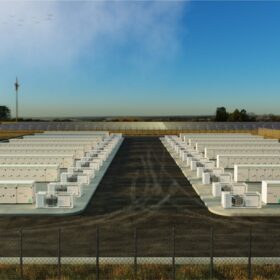PacifiCorp has released the its draft 2019 Integrated Resource Plan (IRP), and if you’re a fan of solar energy, odds are you’re going to like it. If you’re not a fan of solar energy, why are you on this site exactly?
Under the utility’s “preferred portfolio” in the previously mentioned IRP, PacifiCorp plans to add 6.5 GW of renewables by 2025 and 600 MW of battery storage by 2025. The utility notes that this is the first time in its history that batteries are a part of its chosen, least-cost portfolio.
Of those 6.5 GW of renewables, 3.5 will come from wind generation, with the remaining 3 GW coming from solar. By 2038, those numbers increase to 4.6 GW of wind, 6.3 GW of solar and 2.8 GW of battery storage.
And, in an instance of true future-planning beauty, PacifiCorp has also outlined where all of this solar and storage will be developed, down to the last MW.
- 3,000 MW of new solar in Utah paired with 635 MW of battery storage, phased in between 2020 and 2037
- 1,415 MW of new solar in Wyoming paired with 354 MW of battery storage, phased in between 2024 and 2038
- 1,075 MW of new solar in Oregon paired with 244 MW of battery storage, phased in between 2020 and 2033
- 814 MW of new solar in Washington paired with 204 MW of battery storage, phased in between 2024 and 2036
We would now like to welcome you to another edition of the exponential capacity game. This week, our contestants are Utah, Wyoming, Oregon and Washington. First up, Utah, which has a current total installed capacity of 1,671 MW, most of any of our lovely contestants. This means that the additional 3,000 MW represent a nearly 180% increase in solar capacity. Next comes Wyoming, which currently has a total installed solar capacity of 108 MW, making the 1,415 MW on the way a 1,310% increase in capacity, which takes the cake for largest exponential capacity addition ever reported by pv magazine.
Our penultimate contestant, Oregon has a current installed capacity of 612 MW, making the expected 1,075 MW a 176% increase in capacity. Finally comes Washington, where the 814 MW laid out in the IRP represents a 413% increase in capacity over the state’s current mark of 197 MW.
Congratulations, Wyoming, you’re this week’s big winner. Honestly, with this much solar going around, all the states are winners.
And finally, with all these winners running around, somebody has to lose, right? Right, and that loser is coal, as PacifiCorp has made the decision to accelerate the retirement of five coal-fired power plants.
Of the 24 coal units currently serving PacifiCorp customers, the draft plan envisions retirement of 16 of the units by 2030 and 20 of the units by the end of the planning period in 2038. The unit retirements will reduce coal-fueled generation capacity by nearly 2,800 MW by 2030 and by nearly 4,500 MW by 2038.
The early retirees are:
- Jim Bridger 1 (Wyoming) in 2023 instead of 2037
- Naughton 1 and 2 (Wyoming) in 2025 instead of 2029
- Craig 2 (Colorado) in 2026 instead of 2034
- Colstrip 3 (Montana) and 4 in 2027 instead of 2046
- Jim Bridger 2 (Wyoming) in 2028 instead of 2037
Not accelerated but sill on the way out as of the company’s 2017 IRP are: Naughton 3 (Wyoming, 2019); Cholla 4 (Arizona, 2020); Dave Johnston 1-4 (Wyoming, 2027); Hayden 1-2 (Colorado, 2030); Huntington 1-2 (Utah, 2036) and Jim Bridger 3-4 (Wyoming, 2037).
This content is protected by copyright and may not be reused. If you want to cooperate with us and would like to reuse some of our content, please contact: editors@pv-magazine.com.









I am hoping that the solar and wind additions and coal collapse are accelerated in their next IRP. This seems like a slow walk more than anything else. But, I guess it could be worse – looking at you TVA.
This is an interesting fight. Wyoming looks like a big wave of alternative energy is sweeping through the State in the next few years. Yet there are still articles about the Navajo Nation in Arizona buying out bankrupt coal mining assets in Wyoming, the Cloud Peak Energy mines were bought in a bankruptcy auction. The Navajo Nation is infighting because of this acquisition. It is said, this will “save” 1,200 jobs, but at the same time in Arizona, the closure of the NGS coal plant and Kayenta coal mine is somewhere around 500 jobs gone.
A quote from The Hill: “”While NTEC’s position appears to be that it is independent of tribal oversight and can do whatever it wants, the proposed acquisition of Cloud Peak’s assets clearly contradicts tribal policy announced in April naming “clean renewable energy development as the Navajo Nation’s top energy priority.””
Yes I believe the Navajo Nation has finally seen the light and is in various stages of a transition to cleaner energy sources like solar.
This is very good news for the Nation since there are still hundreds of homes without electric service. I can’t even imagine living without electricity.
All lost in this will be the necessary transmission and VAR insertion required as part of the PAC/BHE Gateway West and Central projects to move the renewables to the western load centers with Bridger and Dave Johnston sync generators going away much sooner. That, and with the extremely deep BHE pockets that can develop mega-renewable projects cheaper from the BH +$100B cash hoard, not much opportunity for independent renewable developers.
Will be very interesting to see what happens with the Colstrip 500kV lines in Montana – BPA is pushing their use for MT renewables to WA, but solar development in WA may eat up all the E-W 500 & 230kV transmission capacity there, making them white elephants.